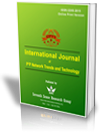Operations Support Systems, Implication of Software Error- Log messages on GSM/GPRS Network Performance
Citation
Otori, A. Uye; Adetiba, O. Ekundayo; Ali, John; John, H. Mormi "Operations Support Systems, Implication of Software Error- Log messages on GSM/GPRS Network Performance". International Journal of P2P Network Trends and Technology (IJPTT), V5(4):1-7 July - Aug 2015, ISSN:2249-2615, www.ijpttjournal.org, Published by Seventh Sense Research Group.
Abstract
GSM/GPRS Network faults dynamic feature can be utilized in the field of Trend/statistical analysis of the error-log message summary for both the Base Station Subsystems and Mobile Switching Centers by comparing the relationship between the twin parameters of Frequency of Occurrence and the Mean Time to Repair (MTTR) each fault type. The Fault Trend Analysis shows that as the number of times a particular fault type occur increases the Mean Time to Repair such faults decreases, with some deviation from this trend in some cases when we classified them as high priority faults with serious impact on network performance and those that have little or no impact on network performance. Filtering and Correlation are two methods we used to simplify the separation of the principal alarms and redundant alarms from their side effect on network performance. A method called Tupling is used to filter and correlate the large volume of error-log message covering a period of three months from Airtel’s network with the resulting summary analysed. The result could be used to reduce total downtime and improve quality of Service (QOS) as per Service Level Agreement.
References
[1] Daniel, P. and Tsao, M. (1983). Trend analysis on systems error profiles. In IEEE Proceedings & Symposium on Fault Tolerant Computing, Milano, Italy.p. 116-119.
[2] David, M. (2007). Nortel Units Performance Management Solutions.Nexus Telecoms whitepaper, Document T – 12 – 00247, Nexus Switzerland. Retrieved June 1, 2010 from http://www.nexus.com/nortelunits/performance
[3] Distaso, J. (1980). The Measurement and Management of Software Reliability. IEEE Trans Software eng. 68(9), 1133-1134.
[4] Hughes, S. (2006). Enterprise architecture for next generation telecommunications service provider. Huges Technical Journal. Retrieved October 12, 2010 from http://www.hsc.com/
[5] Jacobson, G. andWeissman, M. D. (1993, November 10). Alarm Correlation Techniques. IEEE network forum, Stuttgart, Germany. 7(6), 52-59.
[6] Masud, A. (2006). Fault Management in Communications Networks. MSC Thesis. Ahmadu Bello University, Zaria. Retrieved January 7, 2009, from Electrical Engineering departmental library.
[7] Maye, J. and Morvan, G. (2006). Achieving efficient operational transformation.Alactel telecommunications review. 21(3), 253-255.
[8] Nicolas, M., and Peirce–Nenri, G. (2003). Integrated network and service management for Mobile Network.Alcatel telecommunication review. 10(4), 153- 157.
[9] Paessler, M. (2007). Towards a common OSS Architecture. A Journal on Open Element Management System (EMS) Suite by Nokia. Retrieved January 10, 2010 fromwww.nokiasiemensnetworks.com/
[10] Wallstrom, M. (2007). Automation of Mobile Radio Network Performance and Fault Management.MSC Thesis, Helsinki University of Technology.RetrievedJune 7, 2010 from the Department of Electrical Engineering online database.
Keywords
Fault Management, Mean Time to Repair, Tupling, Fault Trend Analysis and Alarms.



